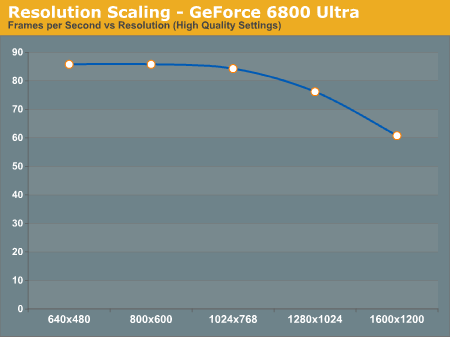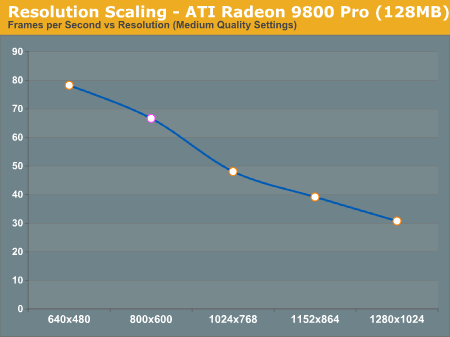In a continuation of Doom 3 Week, we're bringing you the next installment of our coverage, this time focusing on CPU performance. If you haven't already, be sure to read our guide to graphics performance under Doom 3 before proceeding with this guide.
When does Doom 3 Need a Fast CPU?
We know by now that the GPU requirements of Doom 3 are quite high; the days of ultra high resolutions bringing us triple digit frame rates on mid range cards are gone with Doom 3, even cards like the Radeon 9800 Pro are best played at resolutions as low as 800x600. But is a fast GPU all you need to get the most out of Doom 3?
Remember that while your GPU will handle all of the rendering of the scenes in Doom 3, it is the CPU that handles all of the physics, artificial intelligence and 3D setup for sending vertex data to your GPU. So in order to get the most out of a fast GPU, you will also need to pair it up with a fast CPU - but how fast? The basic rule of thumb is this: the faster your GPU is, the faster your CPU will have to be to keep up with it.
Let's take the GeForce 6800 Ultra for example; as you've already seen, the GeForce 6 series is the fastest set of GPUs for running Doom 3, making it an ideal reference point for our discussion.
Below we have a graph of frame rate vs. resolution taken on a Pentium 4 Extreme Edition running at 3.4GHz with a GeForce 6800 Ultra running at 400MHz core/1.1GHz mem. The curve on the graph is what you'll want to pay attention to. If the graph were perfectly flat, as in there was no drop from 640x480 up to 1600x1200, our test system would be completely CPU limited (or bound by something other than the GPU). On the flip side, if the graph showed a clearly negative slope then we would have a much more GPU limited scenario, where the burden of rendering more pixels was not masked by an overly slow CPU.

In this particular case we see that at resolutions below 1280x1024 the GeForce 6800 Ultra is primarily CPU limited, making all of the lower resolutions perform identical to one another. It isn't until we hit 1280x1024 and 1600x1200 that there is a significant performance drop off. So it's clear that if you have a GeForce 6800 Ultra, pairing the chip up with a fast CPU is quite important. But what about on a slower card like a Radeon 9800 Pro?

Here we have a completely different graph, where not even at 800x600 is the card CPU bound. With a Radeon 9800 Pro, having a fast CPU doesn't help as much since you are mostly GPU limited, especially at higher resolutions. This doesn't mean that you can pair up a Radeon 9800 Pro with a 1.4GHz Celeron and be fine, but it does mean that a Pentium 4 Extreme Edition is going to be overkill for your 9800 Pro.
When investigating CPU performance under Doom 3 it's clear that we'll want to use a GeForce 6800 Ultra to put as much stress on the CPU as possible, but we've also looked at how slower cards like the Radeon 9800 Pro react to CPU speed improvements as you'll see on the next page.










59 Comments
View All Comments
Anemone - Thursday, August 5, 2004 - link
I suggest you look at the low and average framerates for the EE @ 1600x1200. From memory I recall on HardOCP was that the AMD chips had a higher top end and a lower low end, making the average, whereas the P4's had high and low ends not so far away from their average.AMD64's fly, but at higher res's 1280 up to 1600, the difference is a few fps, and P4's seem to not fly as fast, but also not bottom out as bad in the super heavy scenes.
While I'm torn on the issue of which platform to go to, that is something I noticed.
DigitalDivine - Thursday, August 5, 2004 - link
Shinei, hardocp did not use apples to apples comparisons.dmxlite - Thursday, August 5, 2004 - link
"When tested at 1600 and real gameplay, Athlon 64 falls like a brick, as shown in the "Official Doom 3 hardware guide" at HardOCP."Yes, that must be the reason why in the conclusion they say "AMD came out ahead in DOOM 3 performance with the strongest CPU in our tests, the Athlon 64 FX-53 processor," and why they chose the stock FX to be in their [H]ard|OCP Ultimate DOOM 3 System and an overclocked A64 3000+ to be in their [H]ard|OCP Ultimate Enthusiast DOOM 3 System.
nlr_2000 - Wednesday, August 4, 2004 - link
It's called an on die memory controller ;)Staples - Wednesday, August 4, 2004 - link
Interesting how P4s were always top dog in Q3 but now with D3, it is the opposite.Shinei - Wednesday, August 4, 2004 - link
I don't know about you, T8000, but I can't complain about my (underclocked) 64MB Ti4200 and 3200+ XP combination. It drags in some areas (9fps as a low, 60 as a high, average gameplay flow is around 20; settings are 10x7 medium quality), but it's definitely playable in singleplayer, with very little mouse lag.So, for my Athlon XP to be performing fairly well with 2-year-old, underclocked hardware, I'm willing to say that HOCP is probably making things retarded for AMD by changing settings or something. I find it very hard to believe that the vastly superior Athlon 64s (compared to my Athlon XP) would falter so heavily in gameplay when my own processor does not.
T8000 - Wednesday, August 4, 2004 - link
I think you cannot say a CPU is better because it produces more frames in situations where it is hardly stressed, like lower resolutions and timedemos. Furthermore, I think most people want to play at an acceptable framerate with as much detail as possible, so testing a GF6800U only at 1280 and without playing the game, is not realistic.When tested at 1600 and real gameplay, Athlon 64 falls like a brick, as shown in the "Official Doom 3 hardware guide" at HardOCP. Only the overclocked Athlon FX could do slightly more then the P4EE at stock settings.
flexy - Wednesday, August 4, 2004 - link
>>>Whether the top-performing FX53 is worth the $811 price is up to you,
>>>
The answer is of course: NO
Neither is the PIV EE worth its price :)
flexy - Wednesday, August 4, 2004 - link
the most important info for me is that it's actually nonsense to wait for socket 939...or useless to spend more money for 1mb cache.So...socket 754 is even better/faster and cheaper. And the 512kb cache are plenty too for the A64.
This is very helpful info in regards to upgrading my system soon :)
Pumpkinierre - Wednesday, August 4, 2004 - link
Nice article Anand- strange set of results. I'd like to see the benchmark for a 2.4c at 3200MHz with same memory latency settings. If it is memory latency as the a64 results suggest then the Prescott should be lower or even beaten by N'wood. If it is L1 cache size then the EE result should be lower.